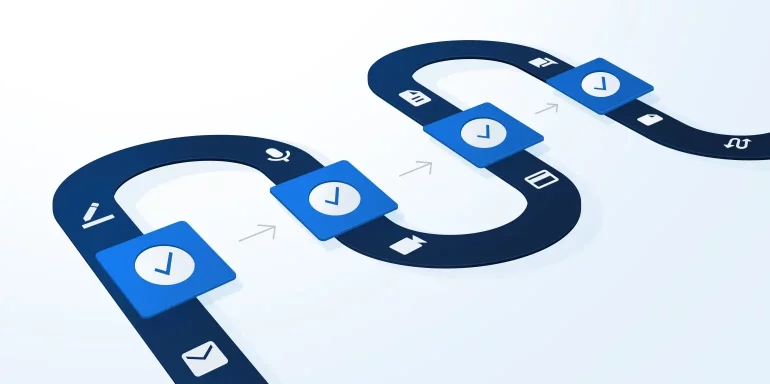Chances are we’ll never meet you, speak to you, or even know what you look like. Still, you’ll make a buying decision about our software based on what you discover online.
That’s the power of content.
Today, throughout the buyer’s journey, consumers are in the driver’s seat. They decide when, where, and how they’ll interact with your brand.
They might like engaging with Tweets via mobile, or they may prefer reading emails on a desktop. Whichever method and medium they choose, one thing’s for sure: They don’t need to communicate with you to make a buying decision.
Pardot cites a statistic that claims today’s buyers will navigate up to 70% of their path to purchase alone. If and when they’re ready to buy, 90% of B2B consumers say they’ll reach out to you:
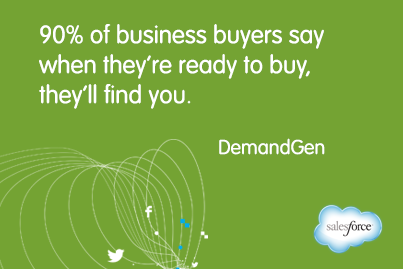
So, if there’s a chance you’ll never even come into contact with your potential customers, how do you prove that you’re better than your competitor — or that you have all the features they need?
Maybe the best way is with a content marketing funnel that mirrors the buyer’s journey.
What is a content marketing funnel?
A content marketing funnel is a trail of content that leads your prospects through the buyer’s journey with targeted information depending on their behavior and needs in the moment.
In general, people like to receive content based on where they are on the path to purchase. Considering you may never even interact with your prospect, laying a trail of content that guides them through every level of evaluation is crucial to convince them to choose you.
Content examples for every stage of the marketing funnel
Determining what kind of content to offer throughout the customer journey is still a confusing problem for a lot of teams. In an attempt to clear it up, we’re going to take a step back and show you some of the content that Instapage and other businesses use to guide prospects through the marketing funnel.
The awareness stage
Before your prospect can choose a solution, they must first realize they have a problem. And that realization doesn’t always happen the way you’d expect it to. Some problems, it turns out, are more obvious than others.
For example, a dead-obvious, high-awareness problem would be your basement flooding or your car breaking down. These things you can’t ignore because day-to-day life becomes difficult without a solution to them.
At Instapage, we attempt to solve a low-awareness, low-irritation problem. Conversion optimization software is still catching on in the marketing space, and a lot of people still don’t know much about it (though, research shows that’s changing).
So, we have to spend the extra effort involved in showing people that they have a problem — that their conversion rates are lower than they could be.
There’s nothing we can do to make people care more about conversion optimization than their flooded basement, but, there is a way to make them care more about boosting their conversion rates in general.
With blog posts, videos, and podcasts about marketing and conversion optimization, we can point out things like…
- Navigation links are killing your conversion rates.
- Personalization is the key to higher ROI
- Landing page conversion ratios higher than 1:1 are draining your budget.
- Super-successful businesses like Airbnb, Uber, and Oracle use landing pages.
Then, we can boost the reach of those posts with both organic and paid social media updates via LinkedIn, Twitter, and Facebook. We can also optimize them to be found in search engines, where the majority of prospects start the customer journey.
A great way to attract more customers is to find out what keywords your buyer personas are punching into Google. Then, create content around those.
For example, one of our buyer personas is marketing agencies, so we have an entire blog category dedicated to marketing agency tips:
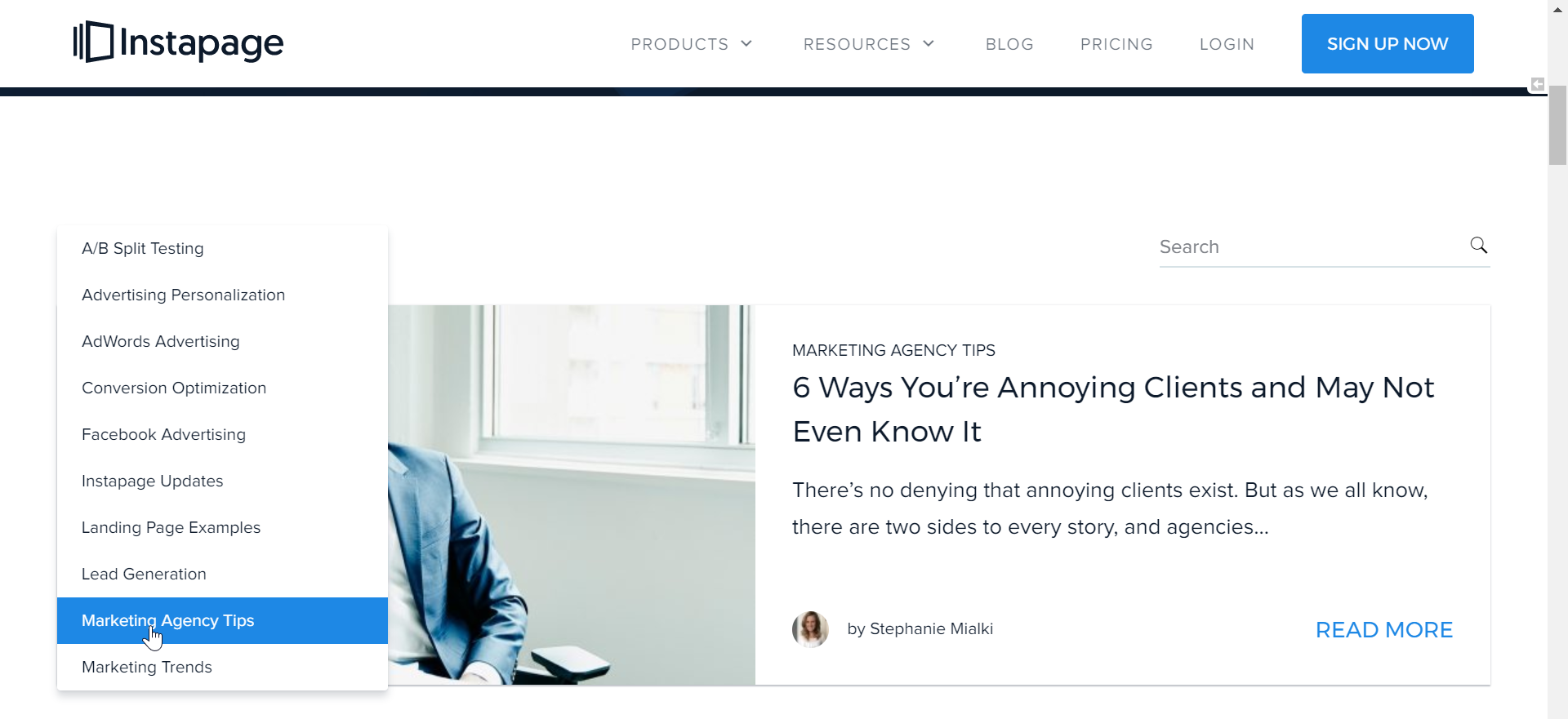
By continuously publishing useful content for our target audience, we keep our brand in the back of their mind. So even if they’re not looking for a landing page solution right now, they’ll remember us when they are. (For more information how to use landing pages at the top of the marketing funnel, check out our guide.)
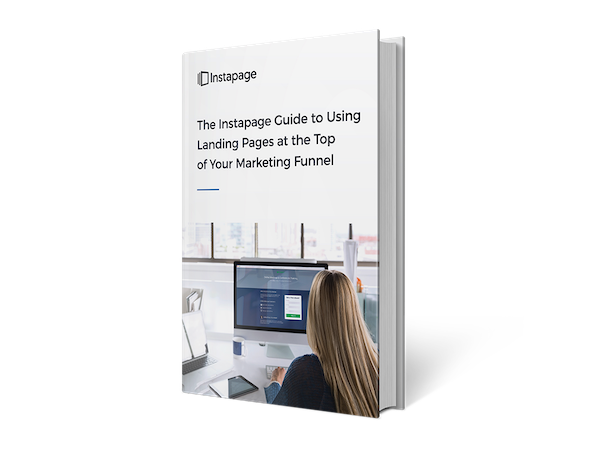
In the awareness stage, free, readily available content like this is how prospects learn they have a problem. It’s also how they identify you as a possible solution to that problem. But, at this point, they’re not even convinced that you’re in the same league as the solution they’re looking for.
Allow us to explain…
The interest stage
For your prospects to reach the interest stage in your content marketing funnel, they have to compare a number of different service categories and decide your class is the one they want to invest in.
If we’re using Instapage as an example, prospects have to choose between a few different solutions to the problem they learned about in the awareness stage. That problem is this:
“We need more landing pages to optimize our advertising campaigns. But, we don’t have the resources to build them.”
Possible solutions to that problem are:
- Hire a developer who can build landing pages from scratch for all our campaigns.
- Contract the work out to a marketing agency who can create landing pages for each of our campaigns.
- Use a software like Instapage to create landing pages ourselves.
To draw prospects to the interest stage, it takes a strong unique selling proposition. At Instapage we can say “we’re more affordable than a marketing agency,” and “using our solution is faster and more cost-effective than hiring a developer to create pages from scratch.”
We emphasize our unique selling proposition using our website content, like the homepage, the product page, and pricing page:
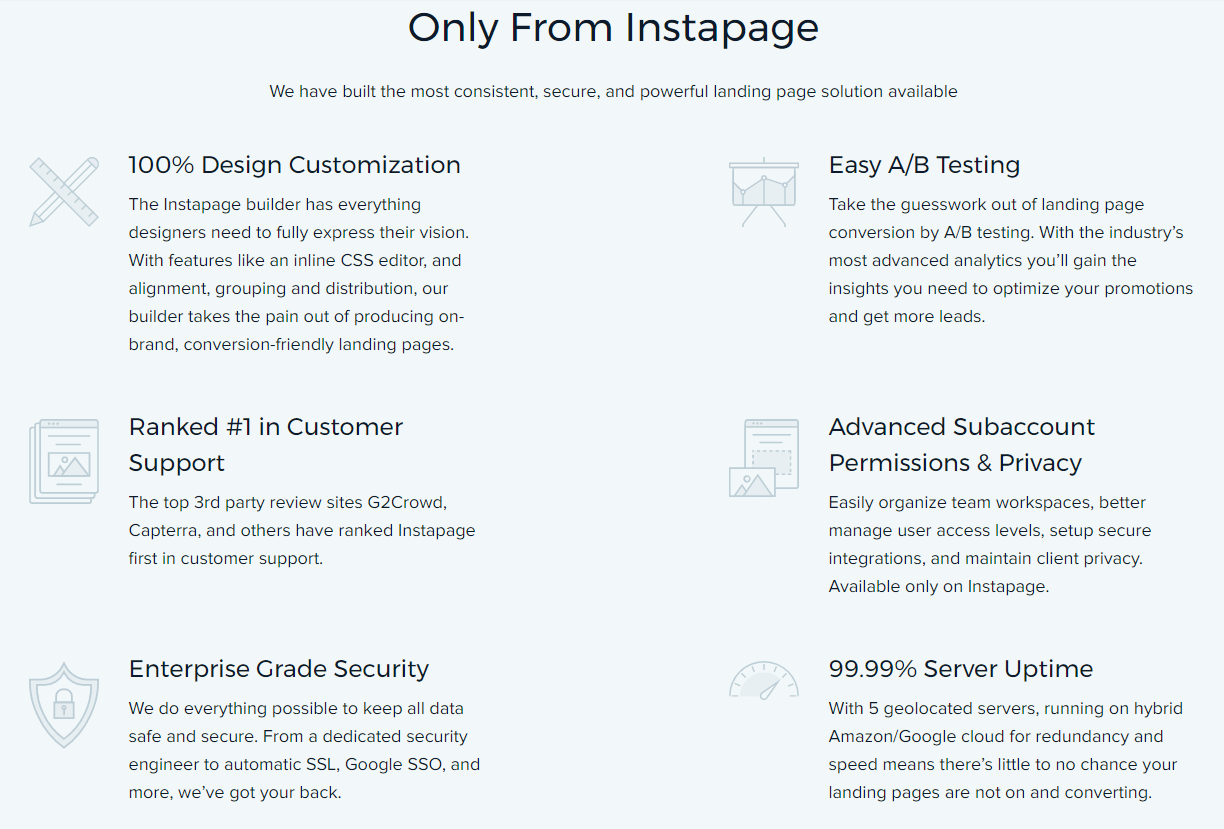
We also do it with blog posts like these:
- What You Need To Know About The Instapage Collaboration Solution
- How To Create A Facebook landing page
Once they get through checking out the website and reading some of our blog posts, ideally prospects say to themselves, “Okay, I’ve decided to go with a landing page solution, and this software is a contender.”
Ultimately, our goal here is to persuade visitors to part with their email address so we can begin a lead nurturing initiative. To get them to do that, we and other businesses use…
Content examples: Tip sheets, ebooks, gated blog posts, guides, squeeze pages
This type of content is ideal for lower top-of-funnel prospects because it doesn’t require too much of a commitment. And we mean that in two ways:
- Tip sheets, ebooks, and blog posts aren’t very dense, so they don’t take long to get through. They contain actionable advice while keeping cognitive strain to a minimum, meaning your visitors don’t have to think too much to get valuable takeaways.
- Landing pages that offer these resources don’t (or shouldn’t) ask for too much in return. So, your visitor will not only get actionable advice without having to think, but they’ll also not have to give up too much to get it.
Here are a few top-of-funnel landing pages that offer light content in exchange for some contact information:
Ebook landing page: SugarCRM
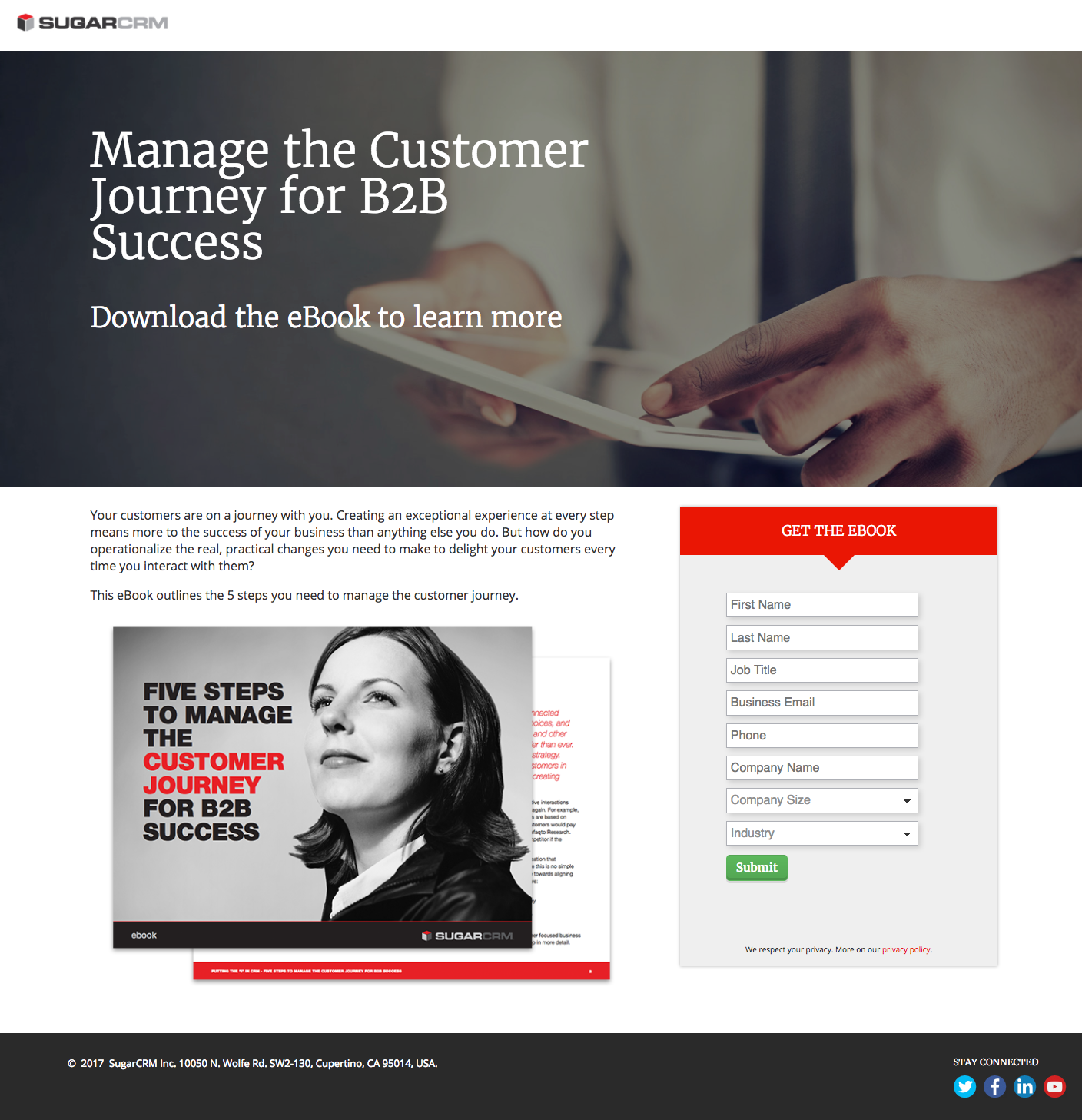
Tip sheet landing page: Social Scaling Formula
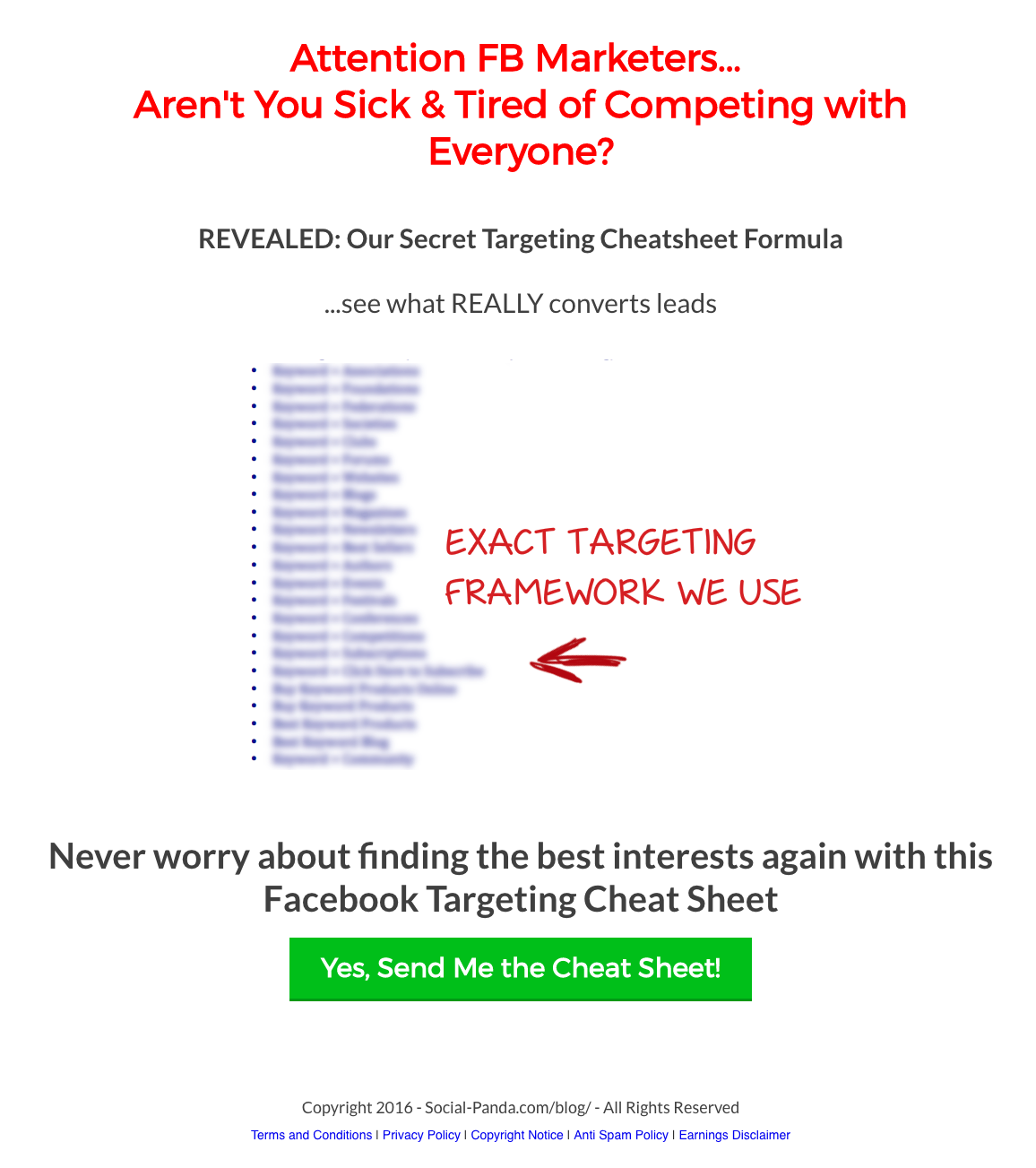
Squeeze page: GQ
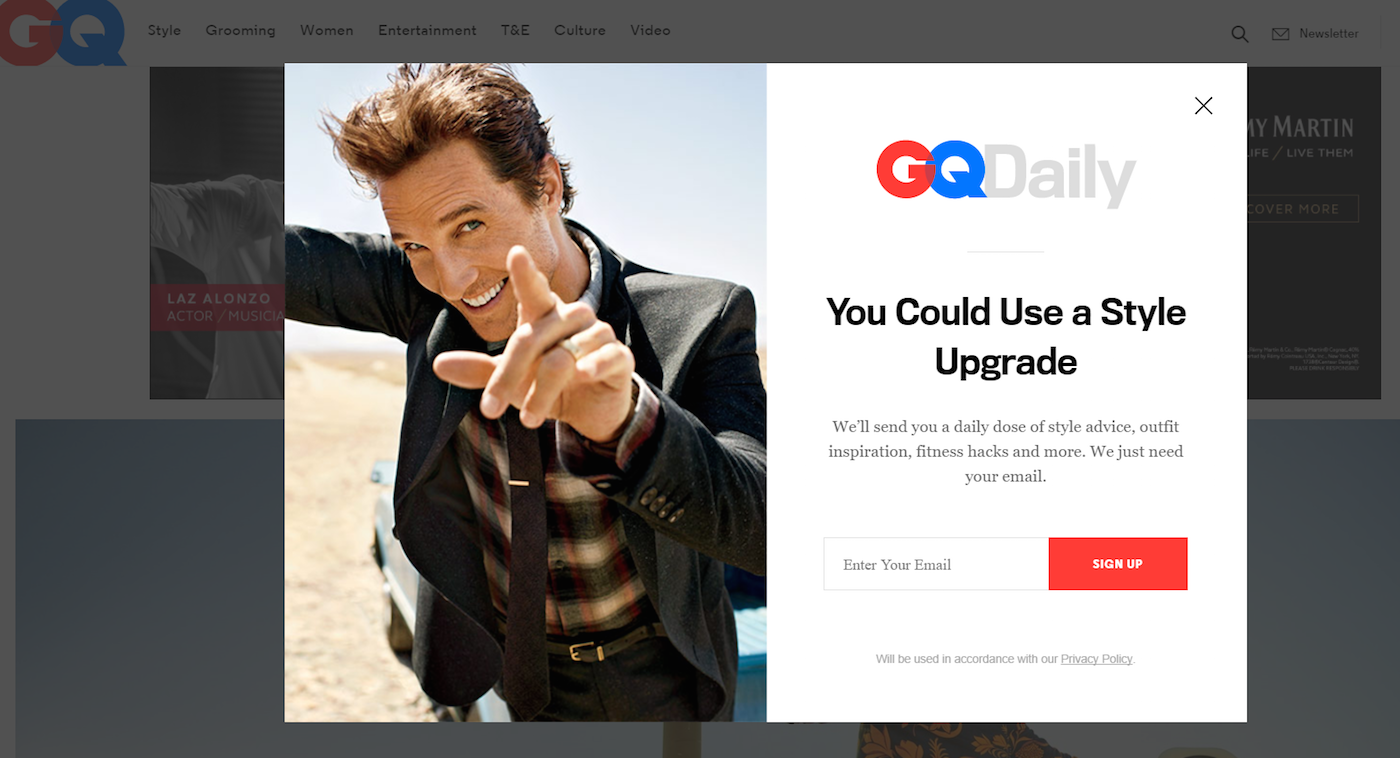
The consideration stage
By this stage, ideally you’ve turned your prospect into a lead. You have some form of contact information that you can use to start nurturing them toward the purchase stage.
This stage is usually the longest in the funnel because there’s a whole lot of stuff going on for both the business and the prospect. Here’s what that is…
First, just because you have an email address doesn’t mean your prospect is going to become a customer. Earning an email address actually isn’t all that hard now:
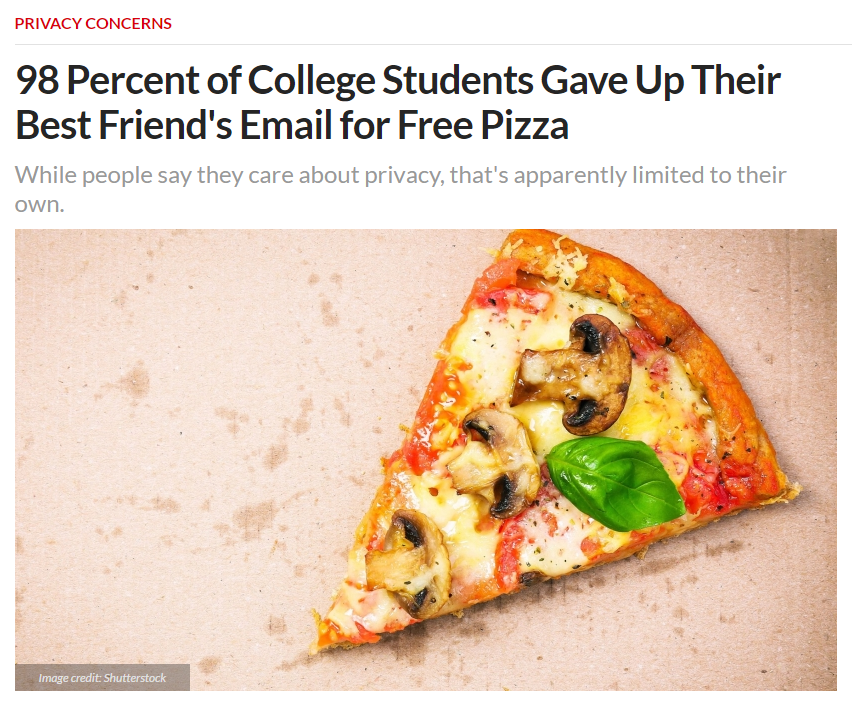
So, in this stage, you’re trying to learn more about your new lead — beyond email address.
Do they have the budget to afford your solution? How big is their team? What’s their role at the company they work for?
To figure out, you’ll dig into your email analytics to discover your lead’s favorite content. Then, based on those reports, you’ll create segments that offer scaled personalization.
You’ll give away more resources via landing pages with bigger lead capture forms. You’ll ask for details that your specific marketing and sales teams need to qualify them.
And with each field your lead fills out, the closer you get to determining whether they’re seriously interested in your product or service.
While you try to figure out who they are, your new lead is trying to figure out what to make of you.
Are you an authoritative source? Can they trust you? Does your solution have everything they need?
They’ll want to see examples of your performance, proof that you’re an industry leader, and resources that show you’re interested in more than their money.
At Instapage, we give prospects a chance to evaluate us via detailed case studies that prove our software can boost their advertising ROI:
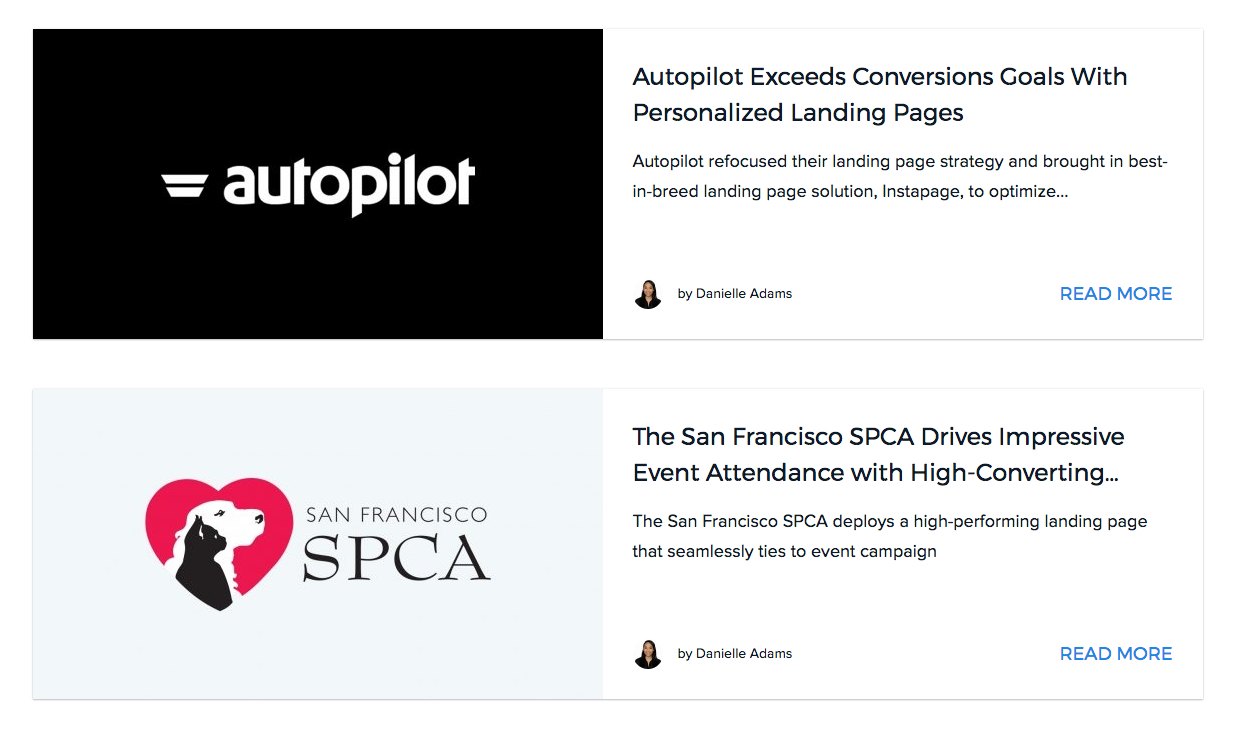
Additionally, we showcase our software’s powerful functionality with master-class webinars:
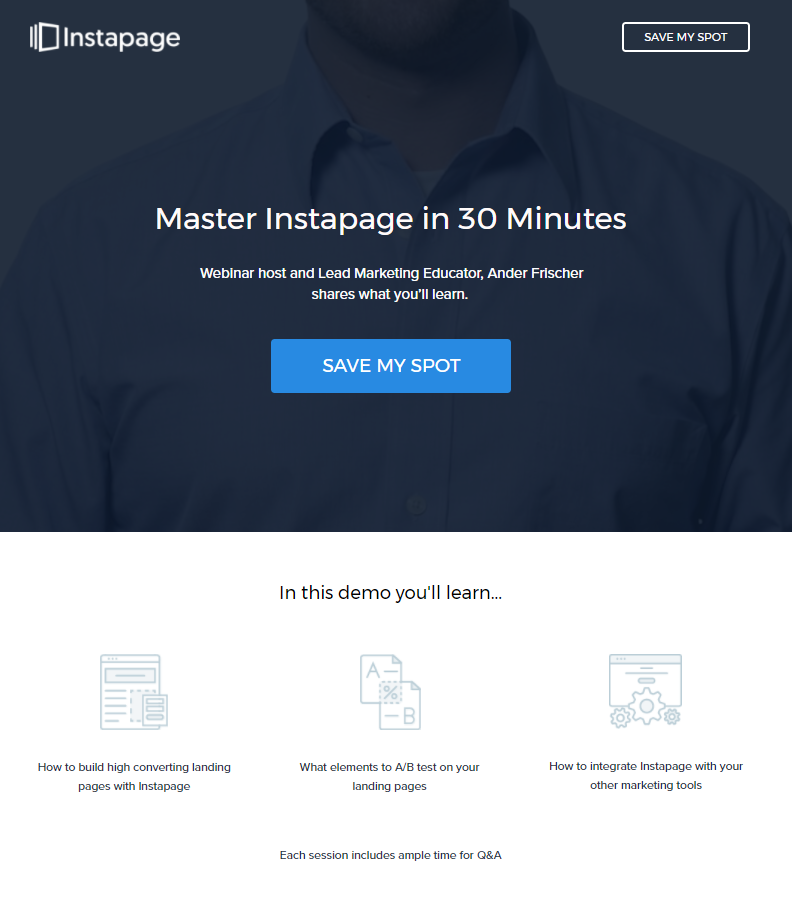
We also have a YouTube playlist dedicated to helping people answer the question: “Why Instapage?”
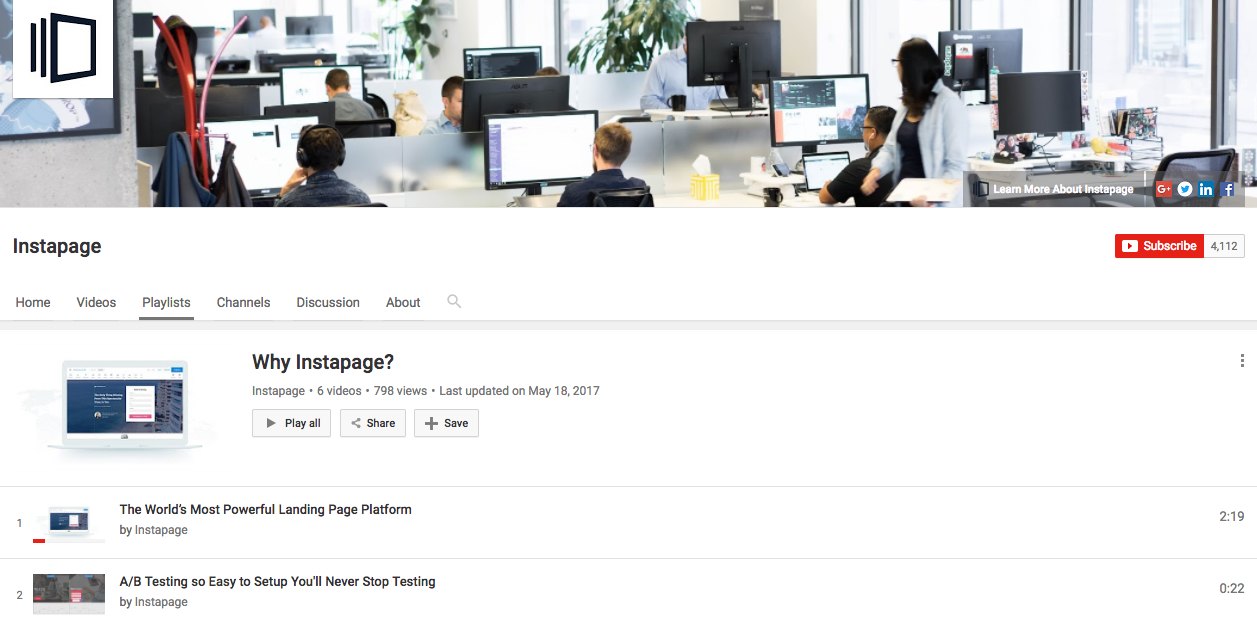
Similarly, to prove you’re better than your competitors, here’s what you’ll want to offer…
Content examples: White papers, case studies, reports, webinars, lead capture landing pages
In this stage, you’re really working to set yourself apart from competitors in the same class. If you’re a web design agency for dentists, you want to prove that you’re better than all the other web design agencies for dentists out there.
The way you’ll want to do it is with unique and highly valuable pieces of content that offer rich data.
By rich data, we mean pieces of content that offer more than your standard ebook or blog post. These provide thought leadership and actionable advice to readers with an emphasis on empirical evidence.
In other words, this content doesn’t just talk the talk; it walks the walk, too. It backs up every tip and takeaway with proof, and it introduces ideas that can’t already be found on the internet. Each type of content in this stage is valuable for different reasons:
- Reports show that you’re an industry leader. They prove that you’re blazing a trail in your field by figuring out the answers to “what’s next?” for your peers and prospects.
- White papers indicate your depth of knowledge by providing a granular look at a normally complicated topic.
- Case studies and blueprints prove that your solution is as valuable as you say it is by showcasing real-life examples of past successes.
- Webinars have been shown to be the single most engaging type of content, capturing viewer attention for an average of nearly an hour. Many times, these are like reports in video form. They go in-depth on a particular topic to display your knowledge and position you as a thought-leader in your industry.
- A lead capture landing page is the tool you’re going to use at this stage to learn more about your visitor. Remember — content isn’t just the resources you offer — it’s also the type of page you offer it with. On these pages, the major focal point will be your form. It should be short enough to keep your prospect from abandoning your page at the thought of filling it out, but long enough to capture a little more information about your lead. The more valuable your resource, the more you can request on your form.
Webinar: Autopilot
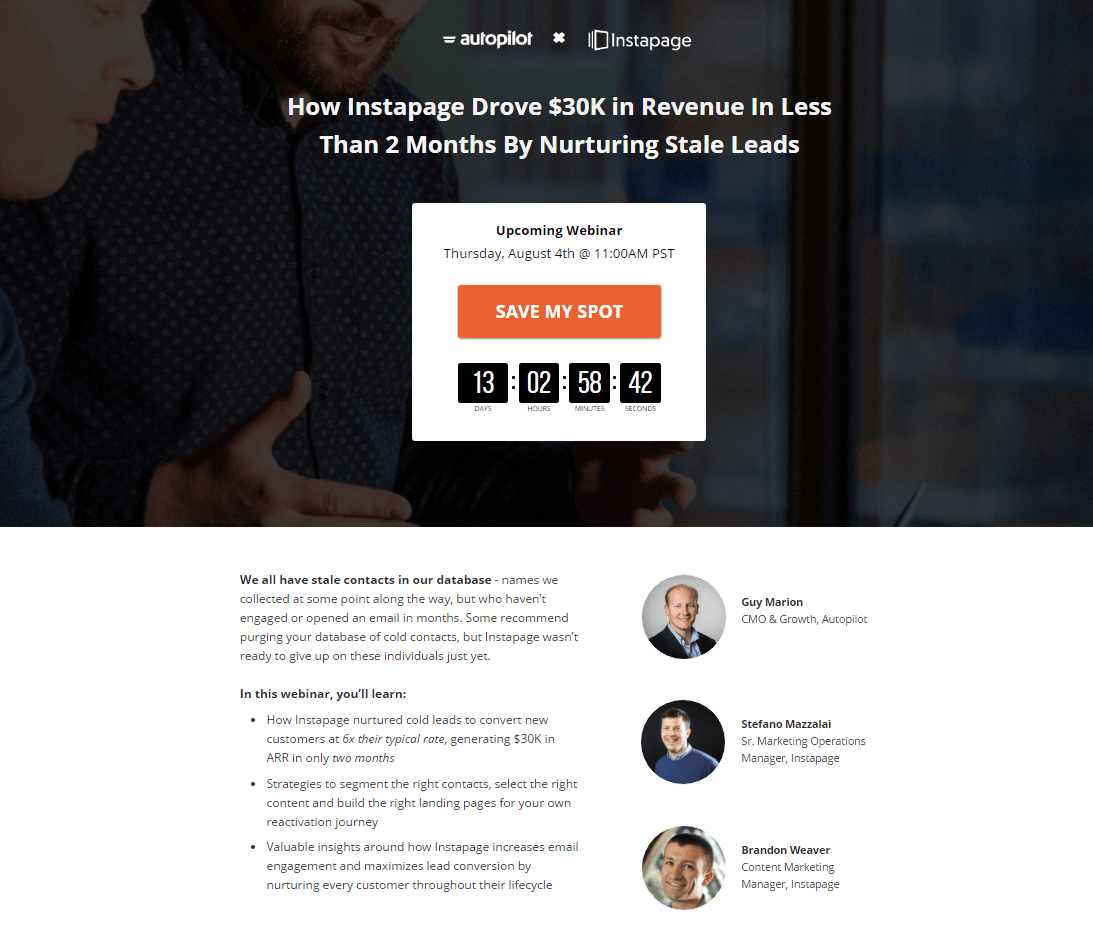
White paper landing page: SAS

The purchase stage
In this stage, your lead’s scrutiny of your product or service is as high as it will be. His hand is on his wallet, but to convince him to open it, it’ll take highly personalized content that proves you can meet his unique needs.
Many times that involves a one-on-one conversation with sales, so it’s crucial make yourself available. A majority of prospects — 62% exactly — say the ability to get in touch with your team via phone is “very important.”
As many as 83% of people also say they need customer support before making an online purchase. Beyond phone, make your representatives available via email, and consider integrating with a chat app, like Drift.
Keep in mind, your sales team doesn’t necessarily have to be introduced this late in the funnel. If you can think of a way to get them involved earlier in a strictly helpful, non-selling way, you boost your chances of making the sale. Research has shown that 74% of deals have been awarded to the sales representative and company that was the first to add value.
But “value” can mean a lot of things. If you add high value with content, you may not even have to introduce your sales team into the mix at all.
Content examples: demo, audit, free trial, tool, FAQs, customer stories, sales landing page, click-through landing page
This is going to be the most personalized, persuasive content in your arsenal. A great way to come up with ideas for content at the bottom of your funnel is by figuring out your leads’ biggest objections from both them and your sales team.
What is it they want to know before buying? What are their concerns? The answers to these questions are crucial for creating a high-converting sales page. Here are some examples of content you’ll want to offer in the purchase stage:
Demo: Five9
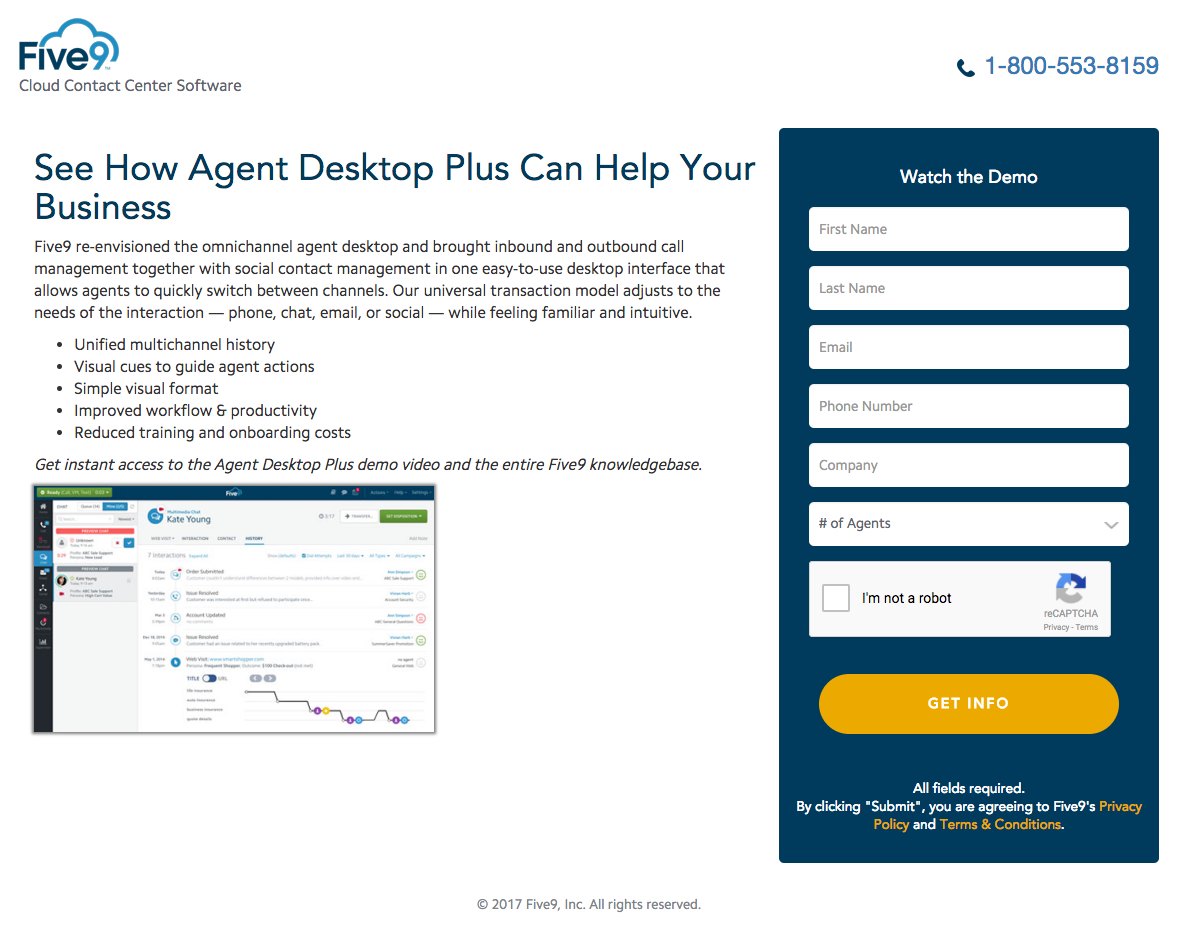
Sales page: Jon Loomer (click through to see the whole page)
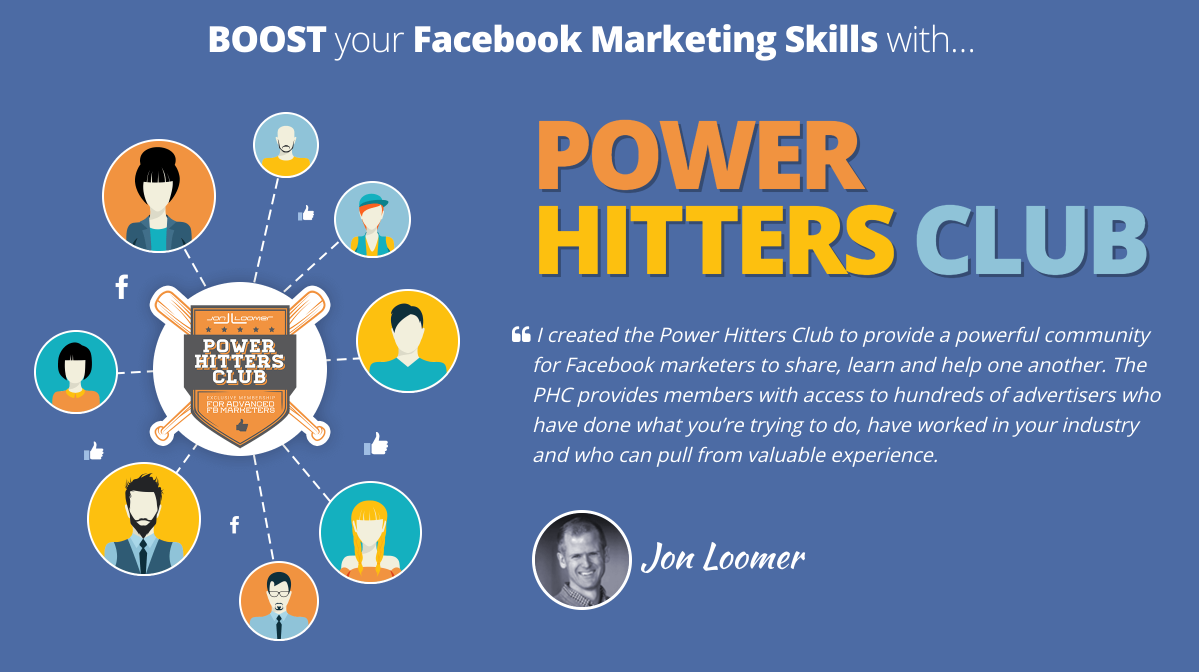
Audit: Louder Online (click through to see the whole page)
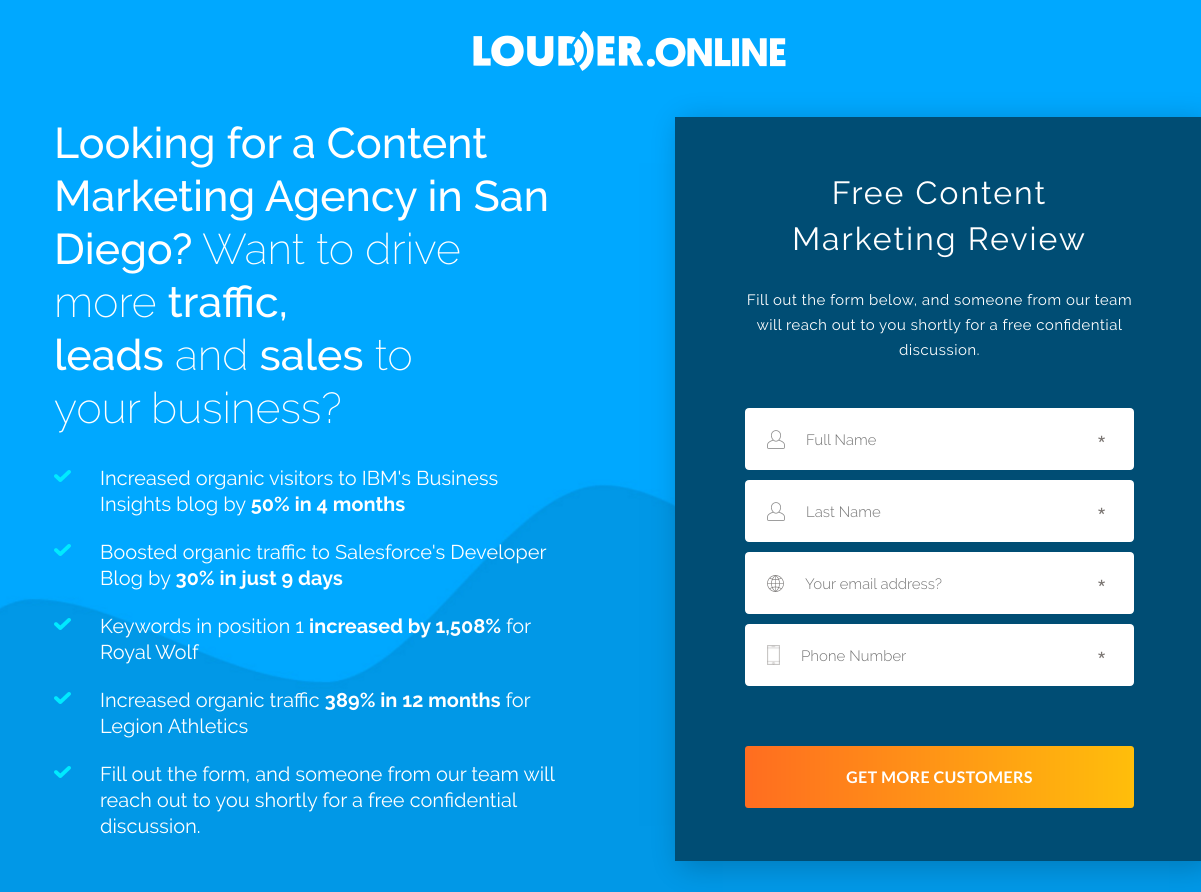
The loyalty stage
In early models of the marketing funnel, this stage wasn’t even included (which doesn’t reflect very well on marketers, does it?). Businesses won their customers, and they considered the buyer’s journey over. But what they didn’t realize is that the key to business growth is convincing customers to buy again.
Customer lifetime value is a term that describes how much your customer is worth to your business from his first purchase to when he stops spending on your product or service. It’s an important metric to track, considering research has shown that profit is maximized in this stage.
Specifically, one study showed that increasing customer retention by just 5% can boost a company’s profits by nearly 100%. Happy customers spend more on your service, and they’re more likely to tell their friends about you.
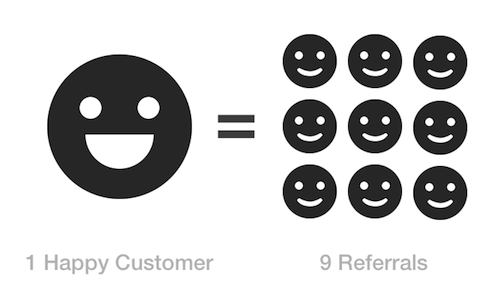
So how do you keep your new customers happy with content?
Content examples: Help desk, social media content, in-app messages, onboarding emails, walkthroughs
The key to succeeding with content in this stage is to make sure your customers are taking full advantage of their new purchase. Stefano Mazzalai calls this the “Aha” moment.
To find out which of Instapage’s features drive the most engagement, our team uses a mix of subscription data and casual conversations with customers — in person and via NPS surveys.
Analysis like this is crucial for finding your most active users, and more importantly, for coming up with content ideas that push your most profitable triggers.
For example, from our qualitative analysis we found out that free trial users who publish a page to a custom domain, and started A/B testing immediately, were 15x more likely to remain engaged and upgrade to a paid plan.
So now we have a sequence of messages which gently suggests to free trial users that they should publish to a custom domain.
To retain customers beyond activation, we use in-app messages, emails, and status updates that continually inform them of ways to use our software while incentivizing them to do so. Here’s an example of an email we send to our most engaged free trial users:
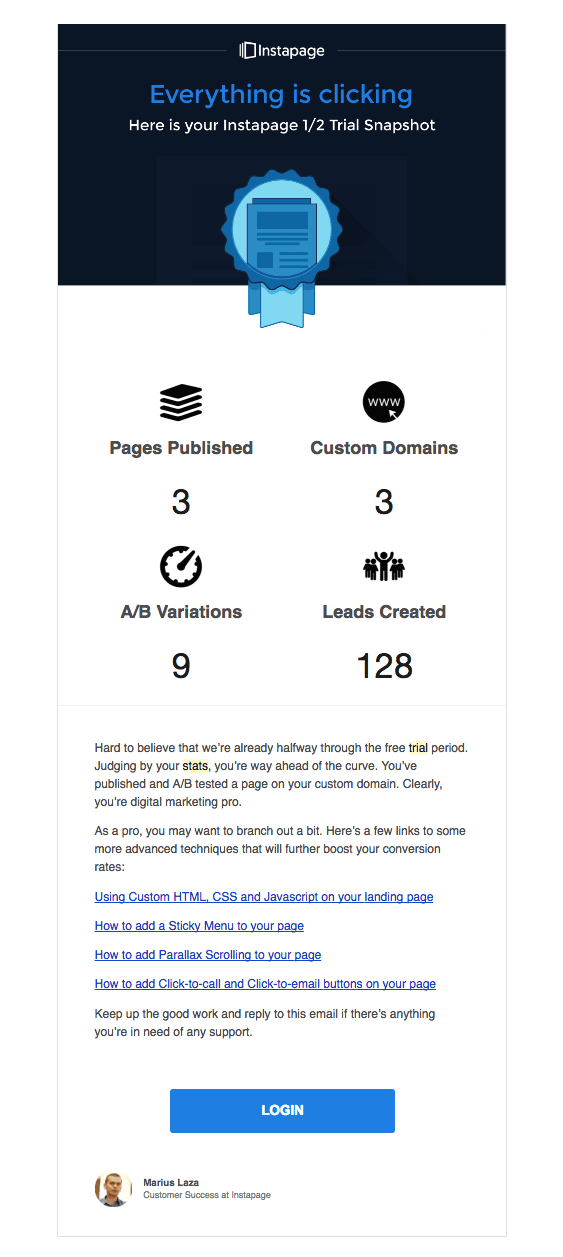
Additionally, as a business founded on personalization, we believe in the tactic strongly. That’s why, upon signup, we find out exactly who our users are so we can continually deliver informative content tailored to their role:
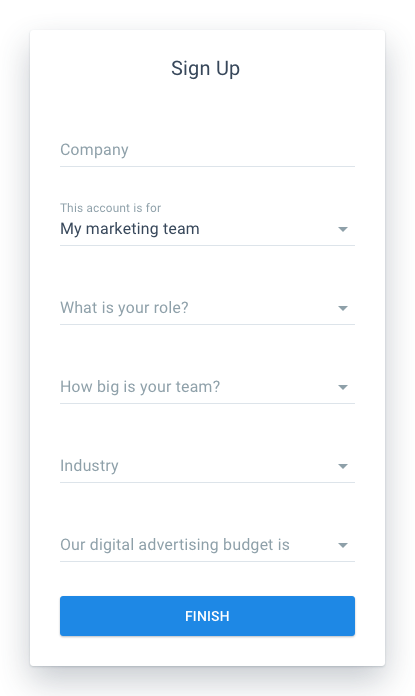
Below is a signup email delivered to the inbox of someone who’s listed their role as “designer:”
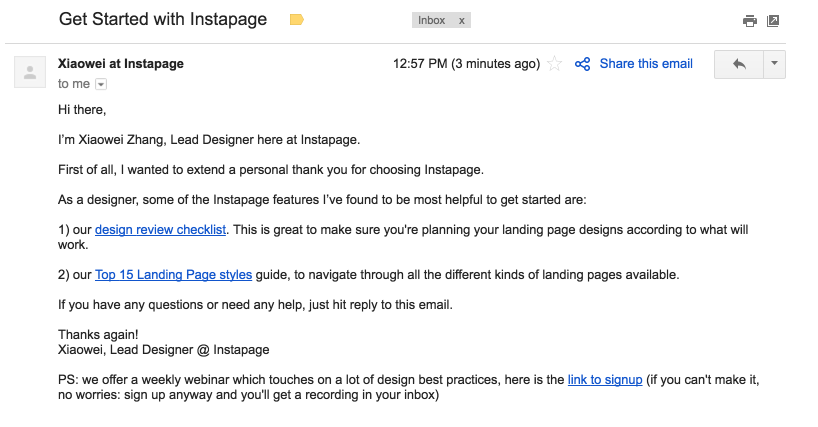
Tailored content like this can come in the form of blog posts, case studies, demonstrations, webinars, videos, and product FAQs for anyone who gets stuck using our software.
And just in case that’s not enough, we have a great social media manager who responds swiftly to every customer issue on channels like Facebook and Twitter. To some that may seem like overkill, but research shows that better human service is what customers want more of from every company’s support team.
An important thing to remember here is that people have unfortunately come to expect lackluster support beyond the purchase stage. So, making them feel special with exclusive members-only content and responding to issues empathetically can do wonders for retention.
These content marketing examples aren’t the only ones
Now that you’re almost through reading, It’s important to hammer home one vital point before you dive further into our funnel or hop into someone else’s:
Content is more than just blog posts and ebooks. Content is everything from your homepage to videos, podcasts, and the push notifications you’re sending to customers’ mobile devices.
There are so many more content examples out there — even ones that have yet to be developed, we’re sure. These are just a few that Instapage and other brands use to guide prospects and leads through the marketing funnel.
Too often we marketers are guilty of maintaining a narrow view of what content is and can be. There’s an easy way to overcome that: Take off your marketing hat and think like a human for a minute. If you were in a content marketing funnel, what would you want to consume?
Ask yourself, and your customers too. Talk to leads and prospects. They’re real people with real problems, and if you’re not in business to solve them, your content will always fall short.
Start delivering exceptional content with the web’s most designer-friendly landing page software, sign up for an Instapage 14-day free trial today.

Try the world's most advanced landing page platform with a risk-free trial.
